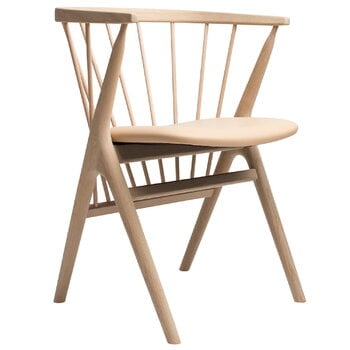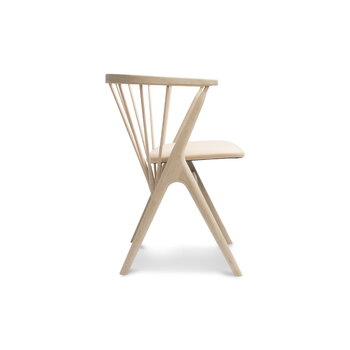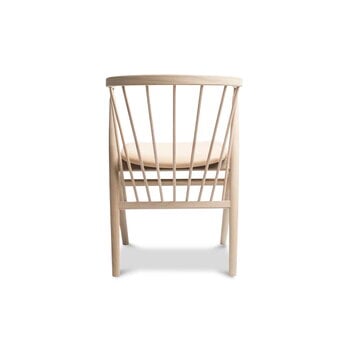Sibast No 8 is an iconic wooden chair and one of the best-known designs of the Danish cabinetmaker Helge Sibast. Designed in 1953, the functional and refined Chair No 8 reflects the principles of the Danish Modern movement, and in the 1950s and 1960s, it made its way to homes around the world. Its airy character comes from a Y-shaped leg structure combined with a curved, spindled backrest that opens up like a fan. The chair is a fine example of modern Danish craftsmanship, and it is part of the Sibast Furniture collection featuring Helge Sibast’s original works and new Danish design.
No 8 chair, soaped oak - honey leather
Sibast
Description
Sibast No 8 is an iconic wooden chair and one of the best-known designs of the Danish cabinetmaker Helge Sibast. Designed in 1953, the functional and refined Chair No 8 reflects the principles of the Danish Modern movement, and in the 1950s and 1960s, it made its way to homes around the world. Its airy character comes from a Y-shaped leg structure combined with a curved, spindled backrest that opens up like a fan. The chair is a fine example of modern Danish craftsmanship, and it is part of the Sibast Furniture collection featuring Helge Sibast’s original works and new Danish design.
Product details (8)
- Colour
- Soaped oak, honey
- Width
- 21.46 in (54.5 cm)
- Height
- 28.94 in (73.5 cm)
- Seat height
- 17.72 in (45 cm)
- Frame material
- Solid oak
- Upholstery fabric
- Ultra Honey 41572 leather
- Notes
- Please note that soap treated oak will develop a patina over time.
- Care instructions
- To minimize the risk of stains and marks, liquid, grease etc. should be removed from the wooden surfaces straight away. For more information on care instructions for soap treated oak, please contact our Customer Service.
- Product ID
Designer
Helge Sibast (1908-1985) was a Danish cabinetmaker and designer who continued the work of his father Peder Olsen Sibast. Besides a skillful carpenter, Helge Sibast was also a visionary designer, and in the 1950s and 1960s his simple, functional and high-quality designs gained success also outside Denmark, and even made their way to the White House. His best known designs, Sibast chairs No 7 and 8, Helge Sibast designed in 1953. In the 21st century Sibast’s tradition is carried on by Sibast Furniture, which was relaunched in 2012 by Helge Sibast’s grandson and his wife.
View all productsReviews (0)
Sustainability
The Product Sustainability Framework, our criteria of sustainable design, helps you find the most sustainable products in our selection. Read below which sustainability criteria this product has met.
Working conditions & labour 6/9
-
Equal opportunities for all employees
-
Commitment to UN Global Compact, fair compensation for all employees
-
Corporate responsibility requirements defined and communicated for suppliers
-
Systematic work for improved inclusion and well-being in the workplace
-
Transparent supply chain
-
Compliance to the UN Guiding Principles on Business and Human Rights ensured in the supply chain
-
Suppliers' compliance to a code of conduct ensured
-
Direct suppliers audited and certified
-
Support for community involvement in the supply chain
Eco-friendly production 8/9
-
Fair and resource-wise water-use in production
-
No incineration or landfilling of returned items
-
No use of endangered species as materials
-
No direct environmental emissions or waste (excl. GHGs) from production
-
The sustainability of direct suppliers' production is addressed and monitored
-
Material-efficient and ecological packaging
-
Positive impact on nature’s well-being through operations that regenerate natural ecosystems
-
No potentially harmful chemicals used in own production
-
Production and material sourcing that respect biodiversity, animal rights, and natural ecosystems
Climate impact 4/8
-
Company's direct greenhouse gas emissions identified and commitment to reduction
-
Product's carbon impact identified and commitment to reduction
-
Guidance on energy- and eco-efficient use of the product
-
Carbon neutral or carbon negative product
-
Contribution to climate initiatives beyond the brand’s direct operations
-
Low-carbon or compensated transportation
-
Carbon footprint of the product calculated and goals set to reduce it
-
100 % renewable energy in own production and operations
Sustainable materials 6/6
-
Sustainable and long-lasting material choices
-
No harmful or hazardous substances
-
Responsible raw material sourcing and production
-
Materials suited for circularity: monomaterials, recyclable finishings, renewable or recycled contents etc.
-
Ecological materials: natural, biodegradable, recyclable or recycled contents
-
Outstanding materials in terms of innovativeness, responsibility, sustainability and circularity: local production or sourcing, 100 % recycled content, C2C-certification etc.
Circular design 4/5
-
High aesthetic quality promoting long-term use of the product
-
Technically durable product design and material choices
-
Design for enduring life-long quality
-
Design and support for product maintenance, repair and upgradability
-
Innovative circular design solutions: circular service system, resale platform, remanufacturing, collection of used products, etc.










